Acoustech Labs SA6.5B Rebuild Project
last updated: 13 April 2011
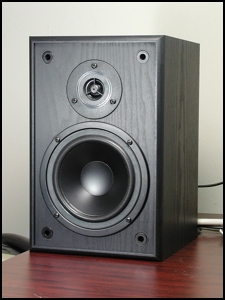
IntroductionThis started off as a fairly simple project - one of my friends managed to blow the drivers for his "Acoustech Labs SA6.5B" speakers some months ago, and he asked me if I could source replacement drivers for them.
After seeing the speakers, my first advice was to simply buy new speakers. The cabinets were decent enough for cheap cabinets, with about 6.8 litres each of available internal volume, but the cost of replacing the drivers was likely to be higher than the cost of a new set of the same speakers (CAN $169 according to their website). However, I was looking for another project to try out and this one seemed fairly simple to do (building the cabinets is always the most bothersome task in any of my projects, and I wouldn't have to do that in this case), so I decided to go ahead after he pushed me for a while.
From the image above, it's clear that the tweeter is one of those cheap Audax 3/4" models (or a copy), which made sourcing a replacement quite simple (just needed to find one with a 74 mm flange). I chose to go with the Audax TW01II.
Finding a replacement bass driver proved to be a bit more difficult. The bass driver's flange is 146 mm, but the cutout is 112 mm, and it appears that the only drivers on the market (well, the only ones that I could find!) were a couple of Seas drivers ranging in price from US$40 to US$130. I eventually chose the Seas CA15RLY (the cheapest of the lot) - spending a lot on drivers for this quality of cabinet is probably not a fiscally sound idea :-).
The only disadvantage with the proposed replacement drivers is that they will not be shielded like the originals, but my friend said that this isn't an issue, as they're not going to be used next to his TV.
The original crossover was quite simple and obviously wouldn't suffice, so I asked Madisound to design one for me. That boosts the cost by US$25, and of course there's the cost of the crossover components to consider.
This is the crossover proposed by Madisound:
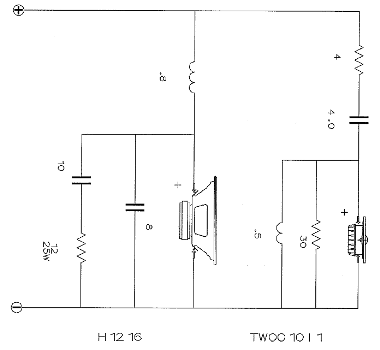
So, the final tally was as follows:
| - | Qty | Unit Cost | Total Cost |
| Drivers | |||
| Seas CA15RLY | 2 | $43.50 | $87.00 |
| Audax TW010I1 | 2 | $8.35 | $16.70 |
| Crossover Components | |||
| 0.8 mH inductor | 2 | $5.40 | $10.80 |
| 0.5 mH inductor | 2 | $2.20 | $4.40 |
| 10 uF capacitor | 2 | $2.30 | $4.60 |
| 8 uF capacitor | 2 | $1.95 | $3.90 |
| 4 uF capacitor | 2 | $2.20 | $4.40 |
| 30 Ohm resistor | 2 | $1.00 | $2.00 |
| 12 Ohm resistor (25 W) | 2 | $0.60 | $1.20 |
| 4 Ohm resistor | 2 | $1.00 | $2.00 |
| Circuit Board | 2 | $5.50 | $11.00 |
| Other | |||
LEAP x-over design | $25.00 | ||
Shipping | $8.15 | ||
Total | $181.15 | ||
A brief interruption..As soon as I placed the order for the components with Madisound, Hurricane Ivan hit the island. My house was one of the estimated 10~20% on the island that did not suffer any significant damage. Unfortunately one of the speaker boxes was at the office and it suffered minor water damage - the vinyl became unstuck around the corners at the back of the box. Luckily the wood itself wasn't damaged, otherwise this project would have taken a decidedly different turn! Ivan also affected delivery times, with the components arriving two months after they were ordered.
Build Results (Phase #1)Building the crossovers and installing the drivers took the better part of one afternoon and the listening tests took up the rest of the night. I opted to 100% stuff the boxes and block the rear vent in each box, rather than retune it (the CA15RLY wants a larger box for vented duty, and any vent in the existing boxes probably wasn't going to contribute much to output). I also ended up sealing up the terminal cups with silicone as they leaked like sieves (leaks identified by running low frequency test tones through the speaker and listening for noises that weren't supposed to be there).
Build Results (Phase #1)Building the crossovers and installing the drivers took the better part of one afternoon and the listening tests took up the rest of the night. I opted to 100% stuff the boxes and block the rear vent in each box, rather than retune it (the CA15RLY wants a larger box for vented duty, and any vent in the existing boxes probably wasn't going to contribute much to output). I also ended up sealing up the terminal cups with silicone as they leaked like sieves (leaks identified by running low frequency test tones through the speaker and listening for noises that weren't supposed to be there).
My first impressions are the results are pretty good but a bit bass-shy, and further tweaking may not be required (but I'll probably end up tweaking it anyway). The finished speakers have a "live" sound, and sound best when mounted right up against the wall (incidentally, I'd asked Madisound to design the crossover with this in mind, but I don't know if they took this into consideration). Bass is lighter than what I'm getting from my Mission 751 or Mordaunt Short MS3.20 speakers, but then again the boxes are smaller too and I'm running them sealed. Overall I'm quite happy with the results so far.
Pictures:The following picture shows one of the SEAS CA15RLY drivers. Note the voice coil visible under the support for the spider, suggesting a significant Xmag for such a small driver.
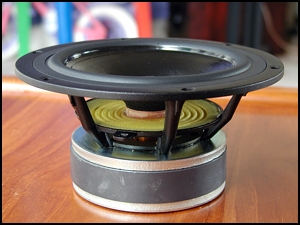
The following picture shows one of the rebuilt speakers next to one of my Mordaunt-Short MS3.20 speakers. The MS3.20 is a fairly old (purchased in the UK for £100 about 13 years ago) speaker and its drivers consist of an Audax (or clone) 3/4" mylar tweeter and a 5.5" polypropylene bass/midrange unit. The rebuilt speaker is more forward-sounding and has less bass than the MS3.20 (understandable, given that the MS3.20 is a vented alignment in a larger cabinet with the same size driver), but it was difficult to decide which one sounded "better".
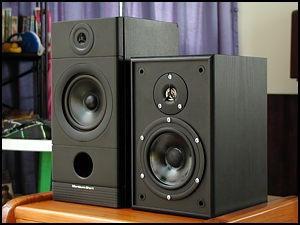
The following picture shows one of the rebuilt speakers next to one of my Mission 751 speakers. The 751 is also fairly old, though not as old as my MS3.20 speakers, and its drivers consist of a 1" dome tweeter and a 5.5" "aerogel" bass unit. This time I tended to prefer the sound of the 751, which had a bit more authority at lower frequencies. But then again, the 751 is vented, and does have a larger cabinet. It also cost £300 when I purchased it several years ago..
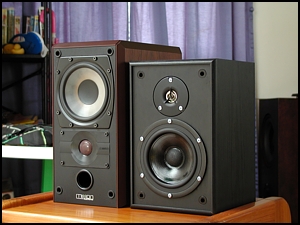
Pictures:The following picture shows one of the SEAS CA15RLY drivers. Note the voice coil visible under the support for the spider, suggesting a significant Xmag for such a small driver.

The following picture shows one of the rebuilt speakers next to one of my Mordaunt-Short MS3.20 speakers. The MS3.20 is a fairly old (purchased in the UK for £100 about 13 years ago) speaker and its drivers consist of an Audax (or clone) 3/4" mylar tweeter and a 5.5" polypropylene bass/midrange unit. The rebuilt speaker is more forward-sounding and has less bass than the MS3.20 (understandable, given that the MS3.20 is a vented alignment in a larger cabinet with the same size driver), but it was difficult to decide which one sounded "better".

The following picture shows one of the rebuilt speakers next to one of my Mission 751 speakers. The 751 is also fairly old, though not as old as my MS3.20 speakers, and its drivers consist of a 1" dome tweeter and a 5.5" "aerogel" bass unit. This time I tended to prefer the sound of the 751, which had a bit more authority at lower frequencies. But then again, the 751 is vented, and does have a larger cabinet. It also cost £300 when I purchased it several years ago..

All things considered, I'm quite happy with the results so far. I expect that the bass response of the rebuilt speakers may improve with some further tweaking, but that really doesn't matter much in the long run, as I expect they will be used in conjunction with a subwoofer. BTW - notice the funky steel screws used in the rebuilt speakers? Well, there are no black screws available locally, so... In any case, I think I like how they look :-).
T/S parameter analysisThe T/S parameters of the Seas CA15RLY are as follows:
| Driver | Seas CA15RLY |
| Vas | 12.0 litres |
| Qes | 0.48 |
| Qts | 0.37 |
| Fs | 47 Hz |
| Re | 5.5 Ohms |
| Effective Diameter | 10.1 cm |
| Xmax | 5 mm |
The parameters suggest that putting one of these drivers into a sealed 6.8 litre box would result in a somewhat bass-shy performance, which is exactly what I experienced. The original rear-mounted vent (1.25" diameter, 2.5" long) tunes the box too high for these drivers, so I may have to do something about it. I decided to try experimenting with a couple of options.
The first thing I tried with stuffing the box. The following is an impedance plot of the sealed box, with 100% stuffing:
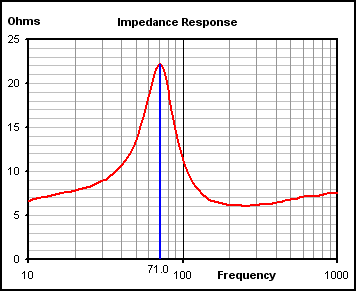
Fb appears to be 71 Hz, instead of the 78 Hz expected from using this driver in this size sealed enclosure. This implies that the effective volume was increased fom 6.8 litres to 9.4 litres, an increase of approximately 38%.
The following is an impedance plot with the vent unsealed:
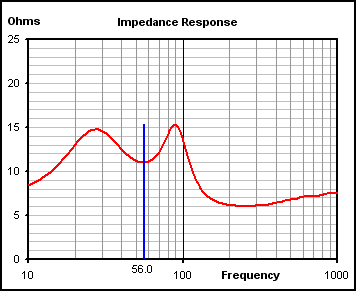
The impedance minimum appears to be at 56 Hz. The midpoint between the two peaks is 50 Hz. This is quite a close match for what I would expect to see if the box was 9.4 litres tuned with the same size vent. The actual frequency response doesn't match though - it approximates a 9.4 litre box tuned to 62 Hz with low Ql (2.5). The response is increased by about 3dB at 80 Hz though, falling off to no increase at 50 Hz..
27-DEC-2004 Update
Just before returning the newly-rebuilt speakers to my friend, I decided to run one more test - a simple tone test to determine if there were any serious resonances in the box. Good thing I did too - at 50 Hz there were definitely other tones present, and it turned out that they were caused by leaks in the box, both on the front and rear panels. It's likely that these leaks partly explain the strange minimum impedance response that I observed above. I sealed up the leaks as best as I could, but there was not enough time to redo the impedance measurements. As for my friend, he's VERY happy with rebuilt speakers - money well spent!
Just before returning the newly-rebuilt speakers to my friend, I decided to run one more test - a simple tone test to determine if there were any serious resonances in the box. Good thing I did too - at 50 Hz there were definitely other tones present, and it turned out that they were caused by leaks in the box, both on the front and rear panels. It's likely that these leaks partly explain the strange minimum impedance response that I observed above. I sealed up the leaks as best as I could, but there was not enough time to redo the impedance measurements. As for my friend, he's VERY happy with rebuilt speakers - money well spent!